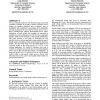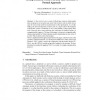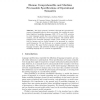59 search results - page 3 / 12 » Applying Formal Methods for Human Error Tolerant Design |
SIAMSC
2008
13 years 7 months ago
2008
The convergence of Multigrid methods can be analyzed based on a Fourier analysis of the method or by proving certain inequalities that have to be fulfilled by the smoother and by t...
BCSHCI
2007
13 years 8 months ago
2007
The use of formal models for user interface design can provide a number of benefits. It can help to ensure consistency across designs for multiple platforms, prove properties such...
FATES
2004
Springer
14 years 24 days ago
2004
Springer
A Time Action Lock is a state of a Real-time system at which neither time can progress nor an action can occur. Time Action Locks are often seen as signs of errors in the model or ...
CHI
2002
ACM
14 years 7 months ago
2002
ACM
We propose a formal experimental paradigm designed to help evaluate scrolling interaction techniques. Such a method is needed by interaction designers to quantify scrolling perfor...
ECMDAFA
2007
Springer
13 years 11 months ago
2007
Springer
Abstract. This paper presents a method to describe the operational semantics of languages based on their meta-model. We combine the established high-level modelling languages MOF, ...



